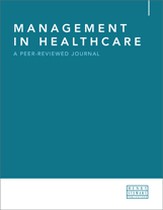Redefining the business value of healthcare infrastructure investment: Introducing plant operating cost correlation coefficients and infrastructure renewal metrics to demonstrate an ROI in reducing deferred maintenance
Abstract
Healthcare organisations face continuous pressure to effectively manage expenses and improve profit margins while meeting the growing demands in the communities they serve. In parallel, the infrastructure is getting older, with deferred maintenance statistics showing that a significant number of US hospitals and the associated mechanical, electrical and plumbing assets required to safely operate those facilities have exceeded industry expected useful life and should be considered for replacement. The data further suggest that without intervention, this ageing trend will continue well into the next decade. Healthcare organisations must also consider hardening facilities against natural disasters and cyber-security threats, improving energy efficiency, reducing carbon emissions and reimagining the role of the facility itself in the future of healthcare. In some cases, these considerations are discretionary, while in others may be mandatory as part of legislative or regulatory requirements. Nevertheless, these requirements create a perfect storm of conflicting financial priorities that will challenge the entire industry for years to come. In the face of these ongoing challenges, traditional methods of budgeting and forecasting may no longer suffice. This paper will define the concept of asset-driven budgeting and introduce plant operating cost correlation coefficients and infrastructure renewal metrics to demonstrate a positive return on investment (ROI) in reducing deferred maintenance. Why? Looking past traditional US$/sq ft metrics, it is important to recognise that the primary cost drivers in any facility are the existing and installed assets themselves, the asset densities required for different service lines and occupancy types, and the age/ design/layout of the facility itself. Without transformational levels of investment to address deferred maintenance and alter the current state of the legacy infrastructure, it can be difficult to achieve anything other than incremental efficiency gains. With infrastructure investment, Risk of Inaction = ROI = Return on Investment.
The full article is available to subscribers to the journal.
Author's Biography
Clayton Smith , MBA, FACHE, SASHE, CHFM, has more than 15 years of experience in healthcare facilities management and more than 10 years in construction management and design. He is currently the Senior Vice President of Facilities Management at Children’s Health System of Texas in Dallas, Texas, where he oversees two campuses with a total of over 5 million sq ft of hospital, clinical and business occupancies. Clayton earned his bachelor’s degree in construction management from Missouri State University and his MBA from Webster University. He is a Fellow in the American College of Healthcare Executives (FACHE) and a Certified Healthcare Facility Manager (CHFM). He was recently a contributor on the ANSI/NEBB standards for new and existing building commissioning and is working with the ASHE taskforce to develop tools for healthcare facility managers.
Mark Mochel , MBA, CHFM, PMP, ACABE, was – before joining Brightly in 2021 – a co-founder and senior vice president at Facility Health Inc., where he was instrumental in introducing new infrastructure investment solutions and benchmarking capabilities to the healthcare industry. Mark has a bachelor’s degree in mechanical engineering from Purdue University and an MBA from The University of Michigan and has held executive leadership roles in multiple industries, providing a unique perspective on the challenges facing healthcare facility management today. Recently elected to serve as an associate member representative on the American Society of Healthcare Engineering (ASHE) National Advisory Board, a Certified Healthcare Facility Manager (CHFM) and an active member of ASHE’s Member Tools Task Force, Mark is uniquely qualified to provide inputs on national trends in healthcare infrastructure investment. Working with health systems across the United States, he is passionate about sharing his experience with all who serve and are served through the environment of care.
Citation
Smith, Clayton and Mochel, Mark (2025, February 13). Redefining the business value of healthcare infrastructure investment: Introducing plant operating cost correlation coefficients and infrastructure renewal metrics to demonstrate an ROI in reducing deferred maintenance. In the Management in Healthcare: A Peer-Reviewed Journal, Volume 9, Issue 3. https://doi.org/10.69554/QWXX4491.Publications LLP
